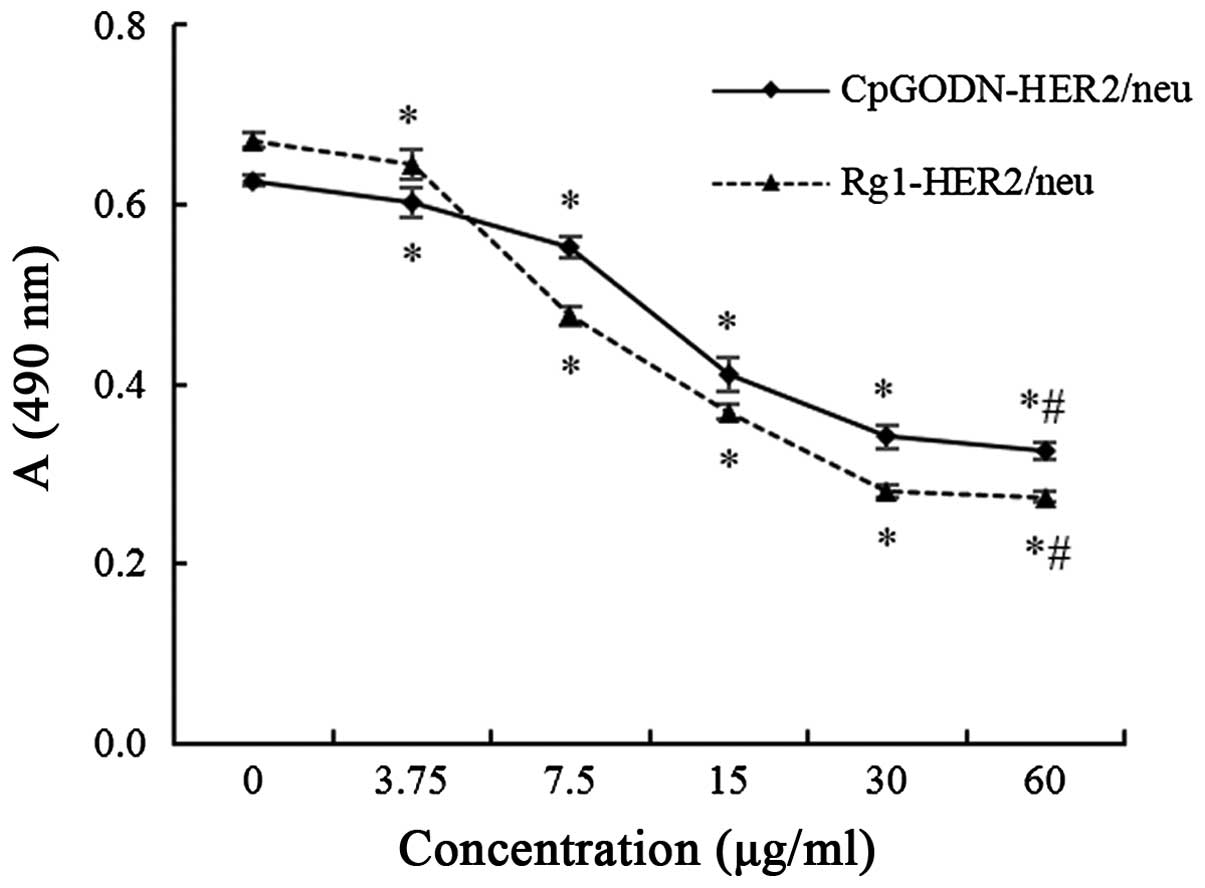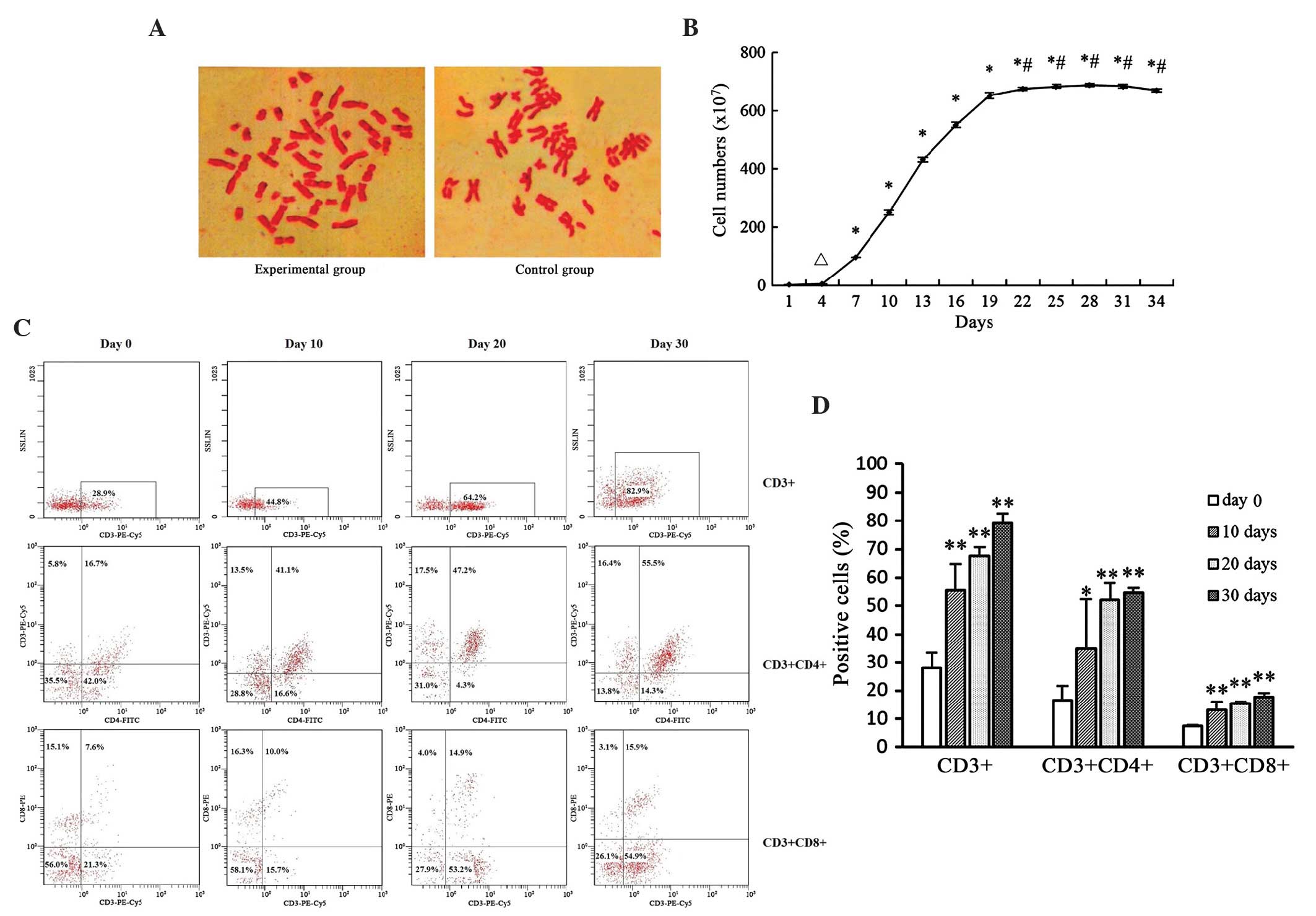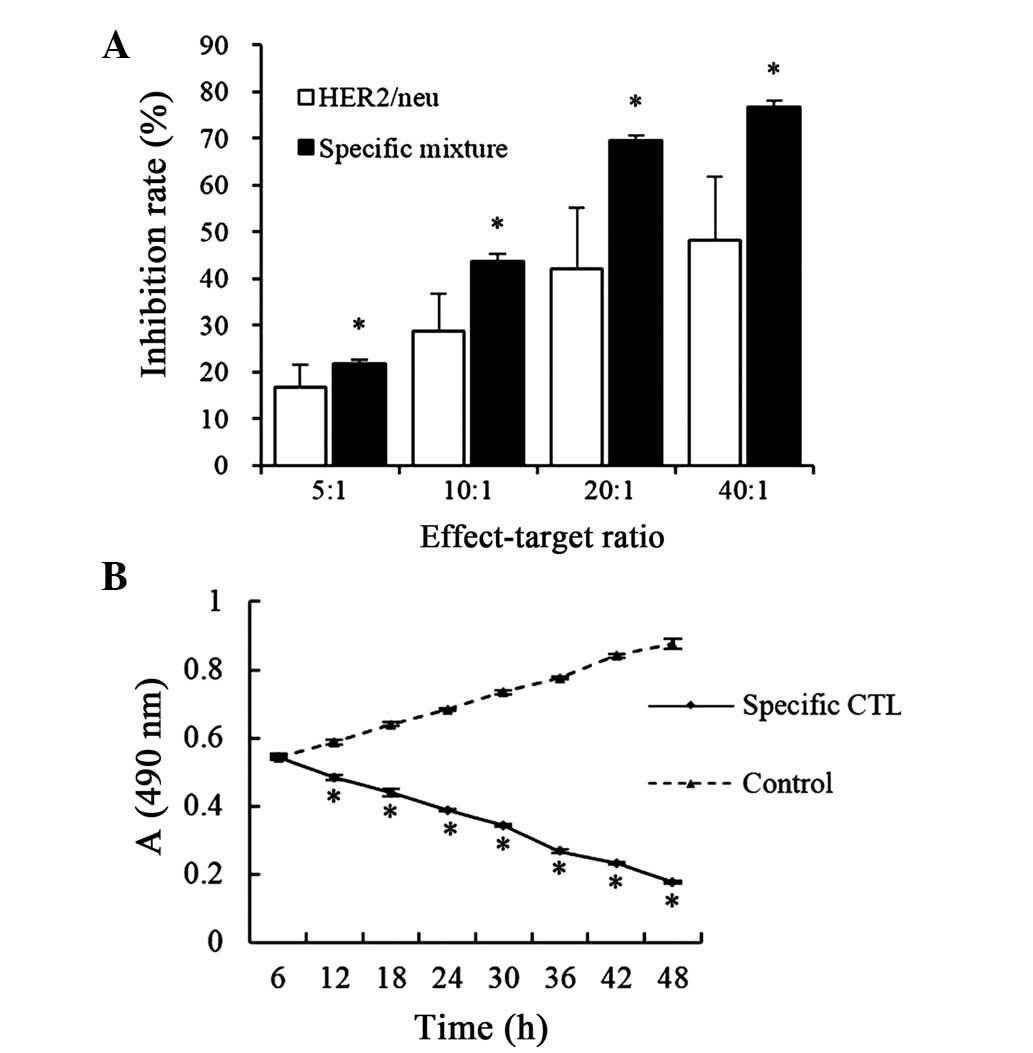|
1
|
Jemal A, Siegel R, Xu J and Ward E: Cancer
statistics, 2010. CA Cancer J Clin. 60:277–300. 2010. View Article : Google Scholar : PubMed/NCBI
|
|
2
|
Bell DA: Origins and molecular pathology
of ovarian cancer. Mod Pathol. 18(Suppl 2): S19–S32. 2005.
View Article : Google Scholar : PubMed/NCBI
|
|
3
|
Lu KH, Skates S, Hernandez MA, Bedi D,
Bevers T, Leeds L, Moore R, Granai C, Harris S, Newland W, et al: A
2-stage ovarian cancer screening strategy using the Risk of Ovarian
Cancer Algorithm (ROCA) identifies early-stage incident cancers and
demonstrates high positive predictive value. Cancer. 119:3454–3461.
2013. View Article : Google Scholar : PubMed/NCBI
|
|
4
|
Cai Y, Tan X, Liu J, Shen Y, Wu D, Ren M,
Huang P and Yu D: Inhibition of PI3K/Akt/mTOR signaling pathway
enhances the sensitivity of the SKOV3/DDP ovarian cancer cell line
to cisplatin in vitro. Chin J Cancer Res. 26:564–572.
2014.PubMed/NCBI
|
|
5
|
Lenhard SM, Bufe A, Kümper C, Stieber P,
Mayr D, Hertlein L, Kirschenhofer A, Friese K and Burges A: Relapse
and survival in early-stage ovarian cancer. Arch Gynecol Obstet.
280:71–77. 2009. View Article : Google Scholar : PubMed/NCBI
|
|
6
|
Mantia-Smaldone GM, Corr B and Chu CS:
Immunotherapy in ovarian cancer. Hum Vaccin Immunother.
8:1179–1191. 2012. View
Article : Google Scholar : PubMed/NCBI
|
|
7
|
Adams SF, Levine DA, Cadungog MG, Hammond
R, Facciabene A, Olvera N, Rubin SC, Boyd J, Gimotty PA and Coukos
G: Intraepithelial T cells and tumor proliferation: Impact on the
benefit from surgical cytoreduction in advanced serous ovarian
cancer. Cancer. 115:2891–2902. 2009. View Article : Google Scholar : PubMed/NCBI
|
|
8
|
Zhang L, Conejo-Garcia JR, Katsaros D,
Gimotty PA, Massobrio M, Regnani G, Makrigiannakis A, Gray H,
Schlienger K, Liebman MN, et al: Intratumoral T cells, recurrence
and survival in epithelial ovarian cancer. N Engl J Med.
348:203–213. 2003. View Article : Google Scholar : PubMed/NCBI
|
|
9
|
Rosenberg SA, Restifo NP, Yang JC, Morgan
RA and Dudley ME: Adoptive cell transfer: A clinical path to
effective cancer immunotherapy. Nat Rev Cancer. 8:299–308. 2008.
View Article : Google Scholar : PubMed/NCBI
|
|
10
|
Berek J, Taylor P, McGuire W, Smith LM,
Schultes B and Nicodemus CF: Oregovomab maintenance
monoimmunotherapy does not improve outcomes in advanced ovarian
cancer. J Clin Oncol. 27:418–425. 2009. View Article : Google Scholar : PubMed/NCBI
|
|
11
|
Dadmarz RD, Ordoubadi A, Mixon A, Thompson
CO, Barracchini KC, Hijazi YM, Steller MA, Rosenberg SA and
Schwartzentruber DJ: Tumor-infiltrating lymphocytes from human
ovarian cancer patients recognize autologous tumor in an MHC class
II-restricted fashion. Cancer J Sci Am. 2:263–272. 1996.PubMed/NCBI
|
|
12
|
Santin AD, Bellone S, Ravaggi A, Pecorelli
S, Cannon MJ and Parham GP: Induction of ovarian tumor-specific
CD8+ cytotoxic T lymphocytes by acid-eluted peptide-pulsed
autologous dendritic cells. Obstet Gynecol. 96:422–430. 2000.
View Article : Google Scholar : PubMed/NCBI
|
|
13
|
Smith KA: Interleukin-2: Inception,
impact, and implications. Science. 240:1169–1176. 1988. View Article : Google Scholar : PubMed/NCBI
|
|
14
|
Gri G, Gallo E, Di Carlo E, Musiani P and
Colombo MP: OX40 ligand-transduced tumor cell vaccine synergizes
with GM-CSF and requires CD40-Apc signaling to boost the host T
cell antitumor response. J Immunol. 170:99–106. 2003. View Article : Google Scholar : PubMed/NCBI
|
|
15
|
Coumes F, Huang CY, Huang CH, Coudane J,
Domurado D, Li S, Darcos V and Huang MH: Design and development of
immunomodulatory antigen delivery systems based on peptide/PEG-PLA
conjugate for tuning immunity. Biomacromolecules. 16:3666–3673.
2015. View Article : Google Scholar : PubMed/NCBI
|
|
16
|
Preston CC, Goode EL, Hartmann LC, Kalli
KR and Knutson KL: Immunity and immune suppression in human ovarian
cancer. Immunotherapy. 3:539–556. 2011. View Article : Google Scholar : PubMed/NCBI
|
|
17
|
Meden H and Kuhn W: Overexpression of the
oncogene c-erbB-2 (HER2/neu) in ovarian cancer: A new prognostic
factor. Eur J Obstet Gynecol Reprod Biol. 71:173–179. 1997.
View Article : Google Scholar : PubMed/NCBI
|
|
18
|
Wang SC and Hung MC: HER2 overexpression
and cancer targeting. Semin Oncol. 28:115–24. 2001. View Article : Google Scholar : PubMed/NCBI
|
|
19
|
Tuefferd M, Couturier J, Penault-Llorca F,
Vincent-Salomon A, Broët P, Guastalla JP, Allouache D, Combe M,
Weber B, Pujade-Lauraine E and Camilleri-Broët S: HER2 status in
ovarian carcinomas: A multicenter GINECO study of 320 patients.
PLoS One. 2:e11382007. View Article : Google Scholar : PubMed/NCBI
|
|
20
|
Høgdall EV, Christensen L, Kjaer SK,
Blaakaer J, Bock JE, Glud E, Nørgaard-Pedersen B and Høgdall CK:
Distribution of HER-2 overexpression in ovarian carcinoma tissue
and its prognostic value in patients with ovarian carcinoma: From
the Danish MALOVA ovarian cancer study. Cancer. 98:66–73. 2003.
View Article : Google Scholar : PubMed/NCBI
|
|
21
|
Teplinsky E and Muggia F: Targeting HER2
in ovarian and uterine cancers: Challenges and future directions.
Gynecol Oncol. 135:364–370. 2014. View Article : Google Scholar : PubMed/NCBI
|
|
22
|
Klinman DM, Klaschik S, Sato T and Tross
D: CpG oligonucleotides as adjuvants for vaccines targeting
infectious diseases. Adv Drug Deliv Rev. 61:248–255. 2009.
View Article : Google Scholar : PubMed/NCBI
|
|
23
|
Xia Y, Gupta GK, Castano AP, Mroz P, Avci
P and Hamblin MR: CpG oligodeoxynucleotide as immune adjuvant
enhances photodynamic therapy response in murine metastatic breast
cancer. J Biophotonics. 7:897–905. 2014. View Article : Google Scholar : PubMed/NCBI
|
|
24
|
Qi LW, Wang CZ and Yuan CS: American
ginseng: Potential structure-function relationship in cancer
chemoprevention. Biochem Pharmacol. 80:947–954. 2010. View Article : Google Scholar : PubMed/NCBI
|
|
25
|
Lee EJ, Ko E, Lee J, Rho S, Ko S, Shin MK,
Min BI, Hong MC, Kim SY and Bae H: Ginsenoside Rg1 enhances CD4(+)
T-cell activities and modulates Th1/Th2 differentiation. Int
Immunopharmacol. 4:235–244. 2004. View Article : Google Scholar : PubMed/NCBI
|
|
26
|
Su F, Yuan L, Zhang L and Hu S:
Ginsenosides Rg1 and Re act as adjuvant via TLR4 signaling pathway.
Vaccine. 30:4106–4112. 2012. View Article : Google Scholar : PubMed/NCBI
|
|
27
|
Posevitz-Fejfár A, Posevitz V, Gross CC,
Bhatia U, Kurth F, Schütte V, Bar-Or A, Meuth SG and Wiendl H:
Effects of blood transportation on human peripheral mononuclear
cell yield, phenotype and function: Implications for immune cell
biobanking. PLoS One. 9:e1159202014. View Article : Google Scholar : PubMed/NCBI
|
|
28
|
Weidanz JA, Nguyen T, Woodburn T,
Neethling FA, Chiriva-Internati M, Hildebrand WH and Lustgarten J:
Levels of specific peptide-HLA class I complex predicts tumor cell
susceptibility to CTL killing. J Immunol. 177:5088–5097. 2006.
View Article : Google Scholar : PubMed/NCBI
|
|
29
|
Conrad H, Gebhard K, Krönig H, Neudorfer
J, Busch DH, Peschel C and Bernhard H: CTLs directed against HER2
specifically cross-react with HER3 and HER4. J Immunol.
180:8135–8145. 2008. View Article : Google Scholar : PubMed/NCBI
|
|
30
|
Mittendorf EA, Holmes JP, Ponniah S and
Peoples GE: The E75 HER2/neu peptide vaccine. Cancer Immunol
Immunother. 57:1511–1521. 2008. View Article : Google Scholar : PubMed/NCBI
|
|
31
|
Vertuani S, Triulzi C, Roos AK, Charo J,
Norell H, Lemonnier F, Pisa P, Seliger B and Kiessling R: HER-2/neu
mediated down-regulation of MHC class I antigen processing prevents
CTL-mediated tumor recognition upon DNA vaccination in HLA-A2
transgenic mice. Cancer Immunol Immunother. 58:653–664. 2009.
View Article : Google Scholar : PubMed/NCBI
|
|
32
|
Shaffer LG and Tommerup N: An
international system for human cytogenetic nomenclature (2005). S
Karger AG; Basel: 2005
|
|
33
|
Stuge TB, Holmes SP, Saharan S,
Tuettenberg A, Roederer M, Weber JS and Lee PP: Diversity and
recognition efficiency of T cell responses to cancer. PLoS Med.
1:e282004. View Article : Google Scholar : PubMed/NCBI
|
|
34
|
Yee C, Gilbert MJ, Riddell SR, Brichard
VG, Fefer A, Thompson JA, Boon T and Greenberg PD: Isolation of
tyrosinase-specific CD8+ and CD4+ T cell clones from the peripheral
blood of melanoma patients following in vitro stimulation with
recombinant vaccinia virus. J Immunol. 157:4079–4086.
1996.PubMed/NCBI
|
|
35
|
Zsiros E, Tanyi J, Balint K and Kandalaft
LE: Immunotherapy for ovarian cancer: Recent advances and
perspectives. Curr Opin Oncol. 26:492–500. 2014. View Article : Google Scholar : PubMed/NCBI
|
|
36
|
Leffers N, Daemen T, Helfrich W, Boezen
HM, Cohlen BJ, Melief CJ and Nijman HW: Antigen-specific active
immunotherapy for ovarian cancer. Cochrane Database Syst Rev.
9:CD0072872014.PubMed/NCBI
|
|
37
|
Powell BS, Andrianov AK and Fusco PC:
Polyionic vaccine adjuvants: Another look at aluminum salts and
polyelectrolytes. Clin Exp Vaccine Res. 4:23–45. 2015. View Article : Google Scholar : PubMed/NCBI
|
|
38
|
Sachamitr P, Hackett S and Fairchild PJ:
Induced pluripotent stem cells: Challenges and opportunities for
cancer immunotherapy. Front Immunol. 5:1762014. View Article : Google Scholar : PubMed/NCBI
|
|
39
|
Montoro E, Lemus D, Echemendia M, Martin
A, Portaels F and Palomino JC: Comparative evaluation of the
nitrate reduction assay, the MTT test, and the resazurin microtitre
assay for drug susceptibility testing of clinicalisolates of
Mycobacterium tuberculosis. J Antimicrob Chemother. 55:500–505.
2005. View Article : Google Scholar : PubMed/NCBI
|

















